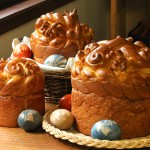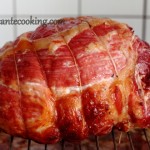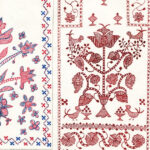The root of many of today’s Ukrainian Christian traditions can be found in ancient pre-Christian times of the culture of early Ukrainians and nowhere is this more evident than in the beautiful tradition of the Easter basket.
During ancient times many Ukrainian customs were connected to the calendar, to nature and to the changing of the seasons. With the coming of Christianity in 988 AD, the colourful, pre-Christian rituals blended with and became integrated into Christian celebrations.
Easter for Ukrainians it is a second big celebration, after Christmas. Easter Day is a public holiday across Ukraine and celebrates Jesus’ resurrection from death, as told in the Christian bible. It is a perfect reason for families and friends to get together. In Ukrainian, Easter is called Velykden (The Great Day), a term used in early Rus’ translations of John Damascene.
40 days before the Easter Ukrainians have to keep a tradition of the Great Lent – meat free, dairy free and egg free.
Meat, eggs and dairy products, according to the Greek-Catholic and Orthodox traditions (two major religions in Ukraine) you allowed to eat on an Easter day and all the days after that – till next lent.
Also, you cannot simply eat meat, eggs and dairy on an Easter Sunday without blessing your food in a church first, so you have to prepare your Easter food basket. Preparing such a basket it is really big deal for every Ukrainian, especially for the women of the house (normally in Ukraine all the cooking, baking and preserving food done by women).
So, what is has to be in a Ukrainian Easter food basket?
Pysankas, which are nicely decorated hard boiled eggs (with shells on – otherwise, how can you decorate?)
Paska, which is sweet egg bread with raisins
Meat products – sausages (mostly garlic ones), ham, smoked bacon (whole piece)
Horseradish root or horseradish with beets (very often both)
Dairy products – butter, cottage cheese or farmer cheese
Salt
These are traditional basics. Other food items that you maybe want to put in your Easter basket are optional. Nowadays I saw plenty of different things people are bringing to bless, like fruits and vegetables, cookies, candies, chocolate etc. Actually, yes, you can fill up your Easter basket with any kind of foods you like, but those traditional basic products for blessing are MUST.
Very-very basics are eggs, Paska (sweet egg bread), sausage and a horseradish, so you can skip dairy products, if you didn’t have time to prepare them or some other reason.
Another big deal for every Ukrainian lady preparing her Easter basket is to decorate the basket nicely – with some greenery, like vinca, myrtus or fern, and some painted wooden Easter eggs or beaded Easter eggs, a candle and an embroidered cover.
A blessing an Easter food baskets is held on Saturday night, before the Easter Sunday, or very early at the morning, on an Easter Sunday – depend on a church schedule.
The ceremony of blessing is really, really nice and festive. Ukrainians like to bring entire family, with kids and grand-kids to a ceremony. People are lining up with their Easter food baskets on the church’s front yard, waiting for a priest with Holy Water to bless the baskets.
Easter food also can be blessed inside of the Church.
So, an Easter food baskets are blessed.
Church-goers at Easter Sunday Mass greet each other with Христос воскрес! Воістину Воскресе! (Khrystos voskres! Voistynu Voskrese!), which means “Christ is risen! Indeed He is risen!” On an Easter Sunday Ukrainians traditionally have an Easter breakfast or Easter brunch, if time is close to afternoon.
Afterwards, the contents of the basket are devoured for breakfast and the candle is placed in the middle of the table and lighted.
The food is left on the table all day for people to nibble as they see fit and to give the women of the house a chance to rest and enjoy the holiday. The basket contents, however, are just a small portion of the delicious spread on the table. Often, holubtsi (stuffed cabbage), mashed potatoes, gravy, pyrohy or varenyky (stuffed dumplings), hot vegetables, cold salads, studenetz (jellied pigs feet) and salchison (headcheese) are also served. And lots of desserts, including syrnyk (cheesecake), poppyseed roll, meringue tortes, cookies and other decadent delights, are offered.
Happy Ukrainian Easter 2017 to everyone who celebrates it!
Symbolic meaning of Easter Basket food
 Paska – This large, round loaf of white bread is elaborately decorated with a braided cross and many rosettes. It symbolizes the joy of the new life given to us by Jesus Christ
Paska – This large, round loaf of white bread is elaborately decorated with a braided cross and many rosettes. It symbolizes the joy of the new life given to us by Jesus Christ
 Ham – The richness of this meat (or sometimes lamb or veal) is symbolic of the great joy and abundance of Easter.
Ham – The richness of this meat (or sometimes lamb or veal) is symbolic of the great joy and abundance of Easter.
2
 Kielbasa – This spicy pork garlic sausage is indicative of God’s love and generosity.
Kielbasa – This spicy pork garlic sausage is indicative of God’s love and generosity.
 Cheese – The traditional cheese used is cottage cheese. Its bland taste reminds us of the moderation that we should cultivate in our lives.
Cheese – The traditional cheese used is cottage cheese. Its bland taste reminds us of the moderation that we should cultivate in our lives.
2
 Eggs – Hard boiled eggs are symbolic of new life – Christ’s death and resurrection. Eggs that have been intricately decorated are called Pysanky.
Eggs – Hard boiled eggs are symbolic of new life – Christ’s death and resurrection. Eggs that have been intricately decorated are called Pysanky.
 Butter – Butter, often shaped into a lamb or a cross, reminds us of the goodness of Christ, and the importance of sharing with others.
Butter – Butter, often shaped into a lamb or a cross, reminds us of the goodness of Christ, and the importance of sharing with others.
5
 Salt – Salt reminds us that we are committed to be followers of Christ and to carry out His word.
Salt – Salt reminds us that we are committed to be followers of Christ and to carry out His word.
 Horseradish – The horseradish, mixed with grated beets, is symbolic of the passion and death of Christ. It reminds us of the bitterness of sin and of the difficulties we must undergo throughout our earthly life.
Horseradish – The horseradish, mixed with grated beets, is symbolic of the passion and death of Christ. It reminds us of the bitterness of sin and of the difficulties we must undergo throughout our earthly life.
Khrytos Voskres – Christ Is Risen
Many times during the Easter Sunday Liturgy, the happy refrains of “Khrytos Voskres” are sung by the congregation. It is sometimes difficult for church visitors to understand why this tune, and its variations, is repeated so frequently during the Easter season. We should remind our visitors that in the Resurrection of Jesus, we are all resurrected from the bonds of death. Our joyful Easter tune, “Sohlasmo Zaspivaimo” perhaps says it best when it proclaims “With His death He conquered death, and to those in their graves He granted Life!”
Voistynu Voskres – Indeed He Is Risen
Following the Easter Sunday Resurrection Services and Divine Liturgy, Ukrainian families would gather outside the church and exchange the joyful greeting “Khrystos Voskres”! That would be answered with the equally cheerful “Voistynu Voskres”! Hugs and kisses for long absent friends and family would follow, as many would come great distances to be together on this holiday. The family would then return home, where the traditional blessed Easter foods basket would be brought out. The father or head of the household would then begin the Easter breakfast by taking one of the blessed hard boiled eggs and dividing it up among the family members. As each member is given a piece of the egg, the father would proclaim “Khrystos Voskres”! The member would reply “Voistynu Voskres”! The passing out and consumption of the egg was a very important start to the meal. The egg symbolized new life and the Resurrection of Christ, and therefore, the basis of the entire celebration. In eating it together, family unity was strengthened, as was the prospect for a healthy and happy year ahead.










